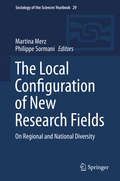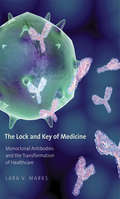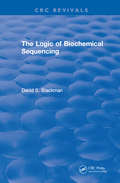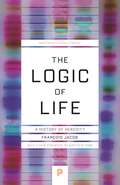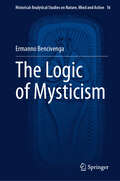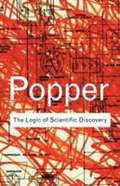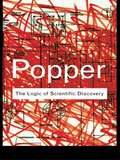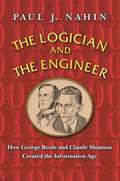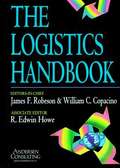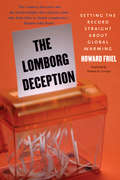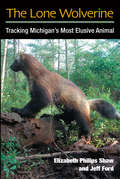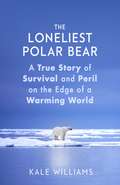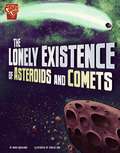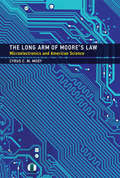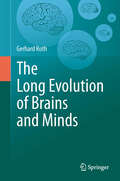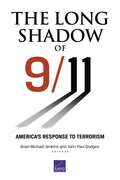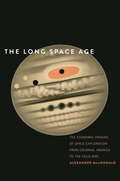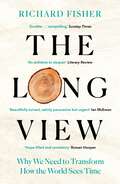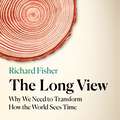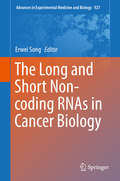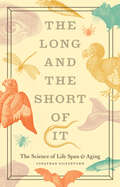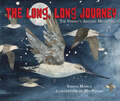- Table View
- List View
The Local Configuration of New Research Fields
by Martina Merz Philippe SormaniThis new Yearbook addresses the question of how policy, place, and organization are made to matter for a new research field to emerge. Bringing together leading historians, sociologists, and organizational researchers on science and technology, the volume answers this question by offering in-depth case studies and comparative perspectives on multiple research fields in their nascent stage, including molecular biology and materials science, nanotechnology, and synthetic biology. The Yearbook brings to bear the lessons of constructivist ethnography and the "practice turn" in Science and Technology Studies (STS) more broadly on the qualitative, comparative, and critical inquiry of new research fields. In doing so, it offers unprecedented insights into the complex interplay of national research policies, regional clusters, particular research institutions, and novel research practices in and for any emerging field of (techno-)science. It systematically investigates national and regional differences, including the variable mobilization of such differences, and probes them for organizational topicality and policy relevance.
The Lock and Key of Medicine
by Lara V. MarksThis book is the first to tell the extraordinary yet unheralded history of monoclonal antibodies. Often referred to as Mabs, they are unfamiliar to most nonscientists, yet these microscopic protein molecules are everywhere, quietly shaping our lives and healthcare. Discovered in the mid-1970s in the laboratory where Watson and Crick had earlier unveiled the structure of DNA, Mabs have radically changed understandings of the pathways of disease. They have enabled faster, cheaper, and more accurate clinical diagnostic testing on a vast scale. And they have played a fundamental role in pharmaceutical innovation, leading to such developments as recombinant interferon and insulin, and personalized drug therapies such as Herceptin. Today Mabs constitute six of the world's top ten blockbuster drugs and make up a third of new introduced treatments. Lara V. Marks recounts the risks and opposition that a daring handful of individuals faced while discovering and developing Mabs, and she addresses the related scientific, medical, technological, business, and social challenges that arose. She offers a saga of entrepreneurs whose persistence and creativity ultimately changed the healthcare landscape and brought untold relief to millions of patients. Even so, as Marks shows, controversies over Mabs remain, and she examines current debates over the costs and effectiveness of these innovative drugs.
The Logic in Philosophy of Science
by Hans HalvorsonMajor figures of twentieth-century philosophy were enthralled by the revolution in formal logic, and many of their arguments are based on novel mathematical discoveries. Hilary Putnam claimed that the Löwenheim-Skølem theorem refutes the existence of an objective, observer-independent world; Bas van Fraassen claimed that arguments against empiricism in philosophy of science are ineffective against a semantic approach to scientific theories; W. V. O. Quine claimed that the distinction between analytic and synthetic truths is trivialized by the fact that any theory can be reduced to one in which all truths are analytic. This book dissects these and other arguments through in-depth investigation of the mathematical facts undergirding them. It presents a systematic, mathematically rigorous account of the key notions arising from such debates, including theory, equivalence, translation, reduction, and model. The result is a far-reaching reconceptualization of the role of formal methods in answering philosophical questions.
The Logic of Biochemical Sequencing
by D. BlackmanThe Logic of Biochemical Sequencing examines how to determine the primary structures of proteins and DNA and use them to stimulate the process of logical problem-solving. It concentrates on sequencing work and stresses the thought processes needed to make sense of what might otherwise be indecipherable data. The book also introduces "biocryptography," which serves as a basis for four short stories that use the results of sequence determinations to provide clues to higher order problems. Problems in the book range from elementary to difficult, and solutions to all problems are provided, many of them completely worked out. The book is an excellent supplementary text for students in a full-year biochemistry course, as well as for biochemists and molecular biologists.
The Logic of Life: A History of Heredity (Princeton Science Library #129)
by François Jacob“The most remarkable history of biology that has ever been written.”—Michel FoucaultNobel Prize–winning scientist François Jacob’s The Logic of Life is a landmark book in the history of biology and science. Focusing on heredity, which Jacob considers the fundamental feature of living things, he shows how, since the sixteenth century, the scientific understanding of inherited traits has moved not in a linear, progressive way, from error to truth, but instead through a series of frameworks. He reveals how these successive interpretive approaches—focusing on visible structures, internal structures (especially cells), evolution, genes, and DNA and other molecules—each have their own power but also limitations. Fundamentally challenging how the history of biology is told, much as Thomas Kuhn’s Structure of Scientific Revolutions did for the history of science as a whole, The Logic of Life has greatly influenced the way scientists and historians view the past, present, and future of biology.
The Logic of Mysticism (Historical-Analytical Studies on Nature, Mind and Action #16)
by Ermanno BencivengaThis book reconciles the worlds of mysticism and logic, building on the author’s previous groundbreaking work in oceanic logic. Historically, the seemingly distinct domains of mysticism and logic have been viewed through a narrow lens through which logic and mysticism have been considered fundamentally separate from each other. The author expands on this concept and argues that logic can be understood in a broader sense. The book reveals that mystics engage in rigorous reasoning, and their writings provide fertile ground for the advancement of logical discourse. The text references insights from the fifth century B.C. through the Middle Ages to the present day, offering a compelling argument for the harmonious integration of logic and mysticism. It challenges conventional wisdom and opens new avenues for understanding the depths of human thought, making it of great interest to those interested in philosophical logic as well as history of science.
The Logic of Scientific Discovery
by Karl R. PopperDescribed by the philosopher A. J. Ayer as a work of 'great originality and power', this book revolutionized contemporary thinking on science and knowledge. Ideas such asthe now legendary doctrine of 'falsificationism' electrified the scientific community, influencing even working scientists, as well as post-war philosophy. This astonishing work ranks alongside. The Open Society and Its Enemies as one of Popper's most enduring books and contains insights and arguments that demand to be read to this day.
The Logic of Scientific Discovery: 14th Printing (Routledge Classics)
by Karl PopperDescribed by the philosopher A.J. Ayer as a work of 'great originality and power', this book revolutionized contemporary thinking on science and knowledge. Ideas such as the now legendary doctrine of 'falsificationism' electrified the scientific community, influencing even working scientists, as well as post-war philosophy. This astonishing work ranks alongside The Open Society and Its Enemies as one of Popper's most enduring books and contains insights and arguments that demand to be read to this day.
The Logician and the Engineer: How George Boole and Claude Shannon Created the Information Age
by Paul J. NahinHow two pioneers of math and technology ushered in the computer revolutionBoolean algebra, also called Boolean logic, is at the heart of the electronic circuitry in everything we use—from our computers and cars, to home appliances. How did a system of mathematics established in the Victorian era become the basis for such incredible technological achievements a century later? In The Logician and the Engineer, Paul Nahin combines engaging problems and a colorful historical narrative to tell the remarkable story of how two men in different eras—mathematician and philosopher George Boole and electrical engineer and pioneering information theorist Claude Shannon—advanced Boolean logic and became founding fathers of the electronic communications age. Nahin takes readers from fundamental concepts to a deeper and more sophisticated understanding of modern digital machines, in order to explore computing and its possible limitations in the twenty-first century and beyond.
The Logistics Handbook
by James F. Robeson William C. Copacino R. Edwin HoweThe Logistics Handbook encompasses all of the latest advances in warehousing and distribution. It provides invaluable "how to" problem-solving tools and techniques for all the ever-increasing logistical problems managers face -- making it the most complete and authoritative handbook to date. Special features include:* The most in-depth coverage of a wide range of topics, including information systems, benchmarking, and environmental issues* Contributions found nowhere else from the leading executives, consultants, and academics in the field, such as C. John Langley, James Heskett, and David Anderson* State of the art graphics* Information-packed appendixes of logistics publications and organizationsThis all-inclusive reference will enable the next generation of managers to thoroughly integrate their logistics operations at all levels -- strategic, structural, functional, and implementation -- into a comprehensive logistics strategy.
The Lomborg Deception: Setting the Record Straight About Global Warming
by Thomas E. LovejoyIn this major assessment of leading climate-change skeptic Bjørn Lomborg, Howard Friel meticulously deconstructs the Danish statistician's claim that global warming is "no catastrophe" by exposing the systematic misrepresentations and partial accounting that are at the core of climate skepticism. His detailed analysis serves not only as a guide to reading the global warming skeptics, but also as a model for assessing the state of climate science. With attention to the complexities of climate-related phenomena across a range of areas--from Arctic sea ice to the Antarctic ice sheet--The Lomborg Deceptionalso offers readers an enlightening review of some of today's most urgent climate concerns. Friel's book is the first to respond directly to Lomborg's controversial research as published inThe Skeptical Environmentalist(2001) andCool It: The Skeptical Environmentalist's Guide to Global Warming(2007). His close reading of Lomborg's textual claims and supporting footnotes reveals a lengthy list of findings that will rock climate skeptics and their allies in the government and news media, demonstrating that the published peer-reviewed climate science, as assessed mainly by the U. N. 's Intergovernmental Panel on Climate Change, has had it mostly right--even if somewhat conservatively right--all along. Friel's able defense of Al Gore'sAn Inconvenient Truthagainst Lomborg's repeated attacks is by itself worth an attentive reading.
The Lone Wolverine: Tracking Michigan's Most Elusive Animal
by Elizabeth Philips Shaw Jeff FordIt began in late winter of 2004. Almost 100 years had passed since the last spotting of a wild wolverine in Michigan when coyote hunters caught a glimpse of one of the animals in a frozen farm field in the northern thumb region. For the next six years, Jeff Ford, a local science teacher and amateur naturalist, devoted himself to locating and filming the wolverine that had unexpectedly and inexplicably appeared in the Wolverine State. By the time hikers found the animal dead in early 2010, Ford had taken hundreds of rare live action photos and shot numerous hours of video, with the story of the "Wolverine Guy" attracting national attention through countless newspaper and magazine articles and appearances on Animal Planet and PBS Nature. This is the tale of Ford's quest as he uncovered answers to mysteries surrounding the animal's territory and movement patterns, while sparking a flurry of controversy surrounding the elusive predator's origin, much of which remains unresolved today. It's an intimate look at research in the raw, from DNA samples stuck on barbed wire to a sophisticated, motion-sensing infrared camera unit strategically placed to observe nocturnal behavior. The Lone Wolverine brings to vivid life this unforgettable piece of American wildlife lore, using candid interviews, public records, and Ford's own vast storehouse of notes, personal writings, correspondence, and images, offering an extraordinary chronicle of a wild wolverine in its natural habitat, at play and in fierce competition for food and survival. This is a wildlife detective story, recounting years of study and fierce debate as researchers pondered the riddles of Michigan's last wolverine---her origins, habits, and ultimately the cause of her untimely death.
The Loneliest Polar Bear: A True Story of Survival and Peril on the Edge of a Warming World
by Kale WilliamsThe heartbreaking and ultimately hopeful story of an abandoned polar bear cub named Nora and the humans working tirelessly to save her and her species, whose uncertain future in the accelerating climate crisis is closely tied to our own. Six days after giving birth, a polar bear named Aurora got up and left her den at the Columbus Zoo, leaving her tiny, squealing cub to fend for herself. Hours later, Aurora still hadn't returned. The cub was furless and blind, and with her temperature dropping dangerously, the zookeepers entrusted with her care felt they had no choice: They would have to raise one of the most dangerous predators in the world themselves, by hand. Over the next few weeks, a group of veterinarians and zookeepers would work around the clock to save the cub, whom they called Nora.Humans rarely get as close to a polar bear as Nora's keepers got with their fuzzy charge. But the two species have long been intertwined. Three decades before Nora's birth, her father, Nanuq, was orphaned when an Inupiat hunter killed his mother, leaving Nanuq to be sent to a zoo. That hunter, Gene Agnaboogok, now faces some of the same threats as the wild bears near his Alaskan village of Wales, on the westernmost tip of the North American continent. As sea ice diminishes and temperatures creep up year-after-year, Gene and the polar bears--and everyone and everything else living in the far north--are being forced to adapt. Not all of them will succeed.Sweeping and tender, The Loneliest Polar Bear explores the fraught relationship humans have with the natural world, the exploitative and sinister causes of the environmental mess we find ourselves in, and how the fate of polar bears is not theirs alone.
The Lonely Existence of Asteroids and Comets
by Mark WeaklandIn graphic novel format, explores asteroids and comets, including their formation, differences, and impact on life on Earth. <P><P> <i>Advisory: Bookshare has learned that this book offers only partial accessibility. We have kept it in the collection because it is useful for some of our members. Benetech is actively working on projects to improve accessibility issues such as these.</i>
The Lonely Phone Booth
by Peter AckermanA sad, forgotten, New York City phone booth becomes a hero in this story of community and caring for others. The Phone Booth on the corner of West End Avenue and 100th Street was one of the last remaining phone booths in New York City. Everyone used it―from ballerinas and birthday clowns, to cellists and even secret agents. Kept clean and polished, the Phone Booth was proud and happy until, the day a businessman strode by and shouted into a shiny silver object, &“I&’ll be there in ten minutes.&” Soon everyone was talking into these shiny silver things, and the Phone Booth stood alone and empty, unused and dejected. How the Phone Booth saved the day and united the neighborhood to rally around its revival is the heart of this touching story. The Lonely Phone Booth has a lot to say about the enduring power of the faithful things in our lives. For children, it&’s a wonderful way to talk about their own communities.&“A story celebrating the fabric of a neighborhood.&” ―New York Times Book Review&“Evoking the same kind of New York charm as favorites like The Little Red Lighthouse and the Great Gray Bridge and The House on East 88th Street, screenwriter Ackerman celebrates a humble phone booth (still standing at 100th Street and West End Avenue) that saves the Upper West Side—and vice versa . . . . Cultural history of the best sort.&” —Publishers Weekly&“The art not only tells a splendid story in and of itself, but it also celebrates the colorful and diverse people who live in New York City.&” —Through the Looking Glass Children&’s Book Review
The Long Arm of Moore's Law: Microelectronics and American Science (Inside Technology)
by Cyrus C. ModyHow, beginning in the mid 1960s, the US semiconductor industry helped shape changes in American science, including a new orientation to the short-term and the commercial.Since the mid 1960s, American science has undergone significant changes in the way it is organized, funded, and practiced. These changes include the decline of basic research by corporations; a new orientation toward the short-term and the commercial, with pressure on universities and government labs to participate in the market; and the promotion of interdisciplinarity. In this book, Cyrus Mody argues that the changes in American science that began in the 1960s co-evolved with and were shaped by the needs of the “civilianized” US semiconductor industry. In 1965, Gordon Moore declared that the most profitable number of circuit components that can be crammed on a single silicon chip doubles every year. Mody views “Moore's Law” less as prediction than as self-fulfilling prophecy, pointing to the enormous investments of capital, people, and institutions the semiconductor industry required—the “long arm” of Moore's Law that helped shape all of science. Mody offers a series of case studies in microelectronics that illustrate the reach of Moore's Law. He describes the pressures on Stanford University's electrical engineers during the Vietnam era, IBM's exploration of alternatives to semiconductor technology, the emergence of consortia to integrate research across disciplines and universities, and the interwoven development of the the molecular electronics community and associated academic institutions as the vision of a molecular computer informed the restructuring of research programs.
The Long Evolution of Brains and Minds
by Gerhard RothThe main topic of the book is a reconstruction of the evolution of nervous systems and brains as well as of mental-cognitive abilities, in short "intelligence" from simplest organisms to humans. It investigates to which extent the two are correlated. One central topic is the alleged uniqueness of the human brain and human intelligence and mind. It is discussed which neural features make certain animals and humans intelligent and creative: Is it absolute or relative brain size or the size of "intelligence centers" inside the brains, the number of nerve cells inside the brain in total or in such "intelligence centers" decisive for the degree of intelligence, of mind and eventually consciousness? And which are the driving forces behind these processes? Finally, it is asked what all this means for the classical problem of mind-brain relationship and for a naturalistic theory of mind.
The Long Shadow of 9/11
by Brian Michael Jenkins John Paul GodgesThis book provides an array of answers to the question, In the ten years since the 9/11 attacks, how has America responded? In a series of essays, RAND authors lend a farsighted perspective to the national dialogue on 9/11's legacy; assess the military, political, fiscal, social, cultural, psychological, and moral implications of U.S. policymaking since 9/11; and suggest options for effectively dealing with the terrorist threat in the future.
The Long Space Age: The Economic Origins of Space Exploration from Colonial America to the Cold War
by Alexander MacDonaldAn economic historian traces uncovers the story of privately funded space exploration from early 19th century astronomical observatories to SpaceX. The standard historical narrative of American space exploration begins during the Cold War, with the federal government&’s efforts to beat the Soviet Union in the Space Race. Given this framing, the more recent emergence of private sector space exploration appears to be a new and controversial phenomenon. But as Alexander MacDonald argues in The Long Space Age, privately funded space exploration had been happening in the United States long before we tried to put a man on the moon. Since the early 19th century, private observatories had been making discoveries and developing technologies that led directly to NASA&’s epochal 20th century achievements. And their efforts were no less ambitious for their time than SpaceX and Blue Origin are in today&’s resurgent space industry.The Long Space Age examines the economic history of this centuries-long development, from those first American observatories to the International Space Station.
The Long View: Why We Need to Transform How the World Sees Time
by Richard Fisher'A beautifully turned, calmly persuasive but urgent book' IAN MCEWAN 'A landmark book that could help to build a much brighter future' DAVID ROBSON A wide-ranging and thought-provoking exploration of the importance of long-term thinking.Humans are unique in our ability to understand time, able to comprehend the past and future like no other species. Yet modern-day technology and capitalism have supercharged our short-termist tendencies and trapped us in the present, at the mercy of reactive politics, quarterly business targets and 24-hour news cycles.It wasn't always so. In medieval times, craftsmen worked on cathedrals that would be unfinished in their lifetime. Indigenous leaders fostered intergenerational reciprocity. And in the early twentieth century, writers dreamed of worlds thousands of years hence. Now, as we face long-term challenges on an unprecedented scale, how do we recapture that far-sighted vision?Richard Fisher takes us from the boardrooms of Japan - home to some of the world's oldest businesses - to an Australian laboratory where an experiment started a century ago is still going strong. He examines the psychological biases that discourage the long view, and talks to the growing number of people from the worlds of philosophy, technology, science and the arts who are exploring smart ways to overcome them. How can we learn to widen our perception of time and honour our obligations to the lives of those not yet born?Praise for The Long View:'A wise, humane book laced with curiosity and hope. It will open your mind and horizons - and leave you giddy at the prospect of all that we may yet become.' Tom Chatfield, author of How to Think 'Hope-filled and revelatory ... Beautifully readable and scholarly, rich and personal, this book shows how, to leave a robust legacy for the future, we need to overcome our bias for the present.' Rowan Hooper, author of How to Spend a Trillion Dollars'A soaring hymn to all that might lie in the future; alongside the diverse and beautiful ways to think about it. Overflowing with wisdom and insight.' Thomas Moynihan, author of X-Risk' In a world of short-sightedness, The Long View is a helpful guide to understand and connect us to the future. In the light of the climate emergency, long-term thinking is more urgent than ever.' Andri Snær Magnason, author of On Time and Water'The Long View is a manifesto calling for a radical reconception of our relationship with time. Richard Fisher documents the social, psychological, and economic reasons we have become stranded on the Island of Now - and charts routes for us to get back to the mainland.' Marcia Bjornerud, the author of Timefulness...
The Long View: Why We Need to Transform How the World Sees Time
by Richard Fisher'A beautifully turned, calmly persuasive but urgent book' IAN MCEWAN 'A landmark book that could help to build a much brighter future' DAVID ROBSON A wide-ranging and thought-provoking exploration of the importance of long-term thinking.Humans are unique in our ability to understand time, able to comprehend the past and future like no other species. Yet modern-day technology and capitalism have supercharged our short-termist tendencies and trapped us in the present, at the mercy of reactive politics, quarterly business targets and 24-hour news cycles.It wasn't always so. In medieval times, craftsmen worked on cathedrals that would be unfinished in their lifetime. Indigenous leaders fostered intergenerational reciprocity. And in the early twentieth century, writers dreamed of worlds thousands of years hence. Now, as we face long-term challenges on an unprecedented scale, how do we recapture that far-sighted vision?Richard Fisher takes us from the boardrooms of Japan - home to some of the world's oldest businesses - to an Australian laboratory where an experiment started a century ago is still going strong. He examines the psychological biases that discourage the long view, and talks to the growing number of people from the worlds of philosophy, technology, science and the arts who are exploring smart ways to overcome them. How can we learn to widen our perception of time and honour our obligations to the lives of those not yet born?Praise for The Long View:'A wise, humane book laced with curiosity and hope. It will open your mind and horizons - and leave you giddy at the prospect of all that we may yet become.' Tom Chatfield, author of How to Think 'Hope-filled and revelatory ... Beautifully readable and scholarly, rich and personal, this book shows how, to leave a robust legacy for the future, we need to overcome our bias for the present.' Rowan Hooper, author of How to Spend a Trillion Dollars'A soaring hymn to all that might lie in the future; alongside the diverse and beautiful ways to think about it. Overflowing with wisdom and insight.' Thomas Moynihan, author of X-Risk' In a world of short-sightedness, The Long View is a helpful guide to understand and connect us to the future. In the light of the climate emergency, long-term thinking is more urgent than ever.' Andri Snær Magnason, author of On Time and Water'The Long View is a manifesto calling for a radical reconception of our relationship with time. Richard Fisher documents the social, psychological, and economic reasons we have become stranded on the Island of Now - and charts routes for us to get back to the mainland.' Marcia Bjornerud, the author of Timefulness...
The Long View: Why We Need to Transform How the World Sees Time
by Richard FisherA wide-ranging and thought-provoking exploration of the importance of long-term thinking.Humans are unique in our ability to understand time, able to comprehend the past and future like no other species. Yet modern-day technology and capitalism have supercharged our short-termist tendencies and trapped us in the present, at the mercy of reactive politics, quarterly business targets and 24-hour news cycles.It wasn't always so. In medieval times, craftsmen worked on cathedrals that would be unfinished in their lifetime. Indigenous leaders fostered intergenerational reciprocity. And in the early twentieth century, writers dreamed of worlds thousands of years hence. Now, as we face long-term challenges on an unprecedented scale, how do we recapture that far-sighted vision?Richard Fisher takes us from the boardrooms of Japan - home to some of the world's oldest businesses - to an Australian laboratory where an experiment started a century ago is still going strong. He examines the psychological biases that discourage the long view, and talks to the growing number of people from the worlds of philosophy, technology, science and the arts who are exploring smart ways to overcome them. How can we learn to widen our perception of time and honour our obligations to the lives of those not yet born?Praise for The Long View:'A wise, humane book laced with curiosity and hope. It will open your mind and horizons - and leave you giddy at the prospect of all that we may yet become.' Tom Chatfield, author of How to Think 'Hope-filled and revelatory ... Beautifully readable and scholarly, rich and personal, this book shows how, to leave a robust legacy for the future, we need to overcome our bias for the present.' Rowan Hooper, author of How to Spend a Trillion Dollars'A soaring hymn to all that might lie in the future; alongside the diverse and beautiful ways to think about it. Overflowing with wisdom and insight.' Thomas Moynihan, author of X-Risk'Few books can claim to shake your perspective on life, but The Long View does exactly that ... a landmark book that could help to build a much brighter future for many generations to come.' David Robson, author of The Expectation Effect'The Long View is a manifesto calling for a radical reconception of our relationship with time. Richard Fisher documents the social, psychological, and economic reasons we have become stranded on the Island of Now - and charts routes for us to get back to the mainland.' Marcia Bjornerud, the author of Timefulness...(P) 2023 Headline Publishing Group Ltd
The Long and Short Non-coding RNAs in Cancer Biology
by Erwei SongThe book conveys a comprehensive knowledge of long and short ncRNAs in cancer regulation and their potentials as diagnostic biomarkers and therapeutic targets. Topics covered include the molecular mechanisms of various classes of ncRNAs (with emphasis on long non-coding RNAs and microRNAs) in cancer, the functional roles of ncRNAs in regulating different cancer hallmarks (including proliferation, apoptosis, stem-cell properties, epithelial-mesenchymal transition, metabolism, angiogenesis, tumor-host interactions and therapeutic resistance), the role of ncRNAs in regulating cancer signaling circuitry programs (highlighting their involvement in c-myc, p53 and NFkB signaling), a systemic summary of clinical and preclinical studies that evaluate the potential of ncRNA signatures for cancer diagnosis and prognosis and strategies to delivery short ncRNAs as therapeutic molecules for cancer treatment. This book may serve as a comprehensive resource for researchers, graduate students and oncologists in ncRNA and cancer research and help drug development by identifying ncRNA targets.
The Long and the Short of It: The Science of Life Span and Aging
by Jonathan SilvertownEverything that lives will die. That's the fundamental fact of life. But not everyone dies at the same age: people vary wildly in their patterns of aging and their life spans--and that variation is nothing compared to what's found in other animal and plant species. A giant fungus found in Michigan has been alive since the Ice Age, while a dragonfly lives but four months, a mayfly half an hour. What accounts for these variations--and what can we learn from them that might help us understand, or better manage, our own aging? With The Long and the Short of It, biologist and writer Jonathan Silvertown offers readers a witty and fascinating tour through the scientific study of longevity and aging. Dividing his daunting subject by theme--death, life span, aging, heredity, evolution, and more--Silvertown draws on the latest scientific developments to paint a picture of what we know about how life span, senescence, and death vary within and across species. At every turn, he addresses fascinating questions that have far-reaching implications: What causes aging, and what determines the length of an individual life? What changes have caused the average human life span to increase so dramatically--fifteen minutes per hour--in the past two centuries? If evolution favors those who leave the most descendants, why haven't we evolved to be immortal? The answers to these puzzles and more emerge from close examination of the whole natural history of life span and aging, from fruit flies, nematodes, redwoods, and much more. The Long and the Short of It pairs a perpetually fascinating topic with a wholly engaging writer, and the result is a supremely accessible book that will reward curious readers of all ages.
The Long, Long Journey: The Godwit’s Amazing Migration
by Sandra Markle Mia PosadaCrackle! Crackle! Crunch! What's hatching from that egg? It's a young bar-tailed godwit. She will spend the summer in Alaska learning to fly, find her own food, and escape from scary predators. Her long, long journey begins in October when she flies to New Zealand. This 7,000-mile flight is the longest nonstop bird migration ever recorded. Follow along on her amazing voyage!
